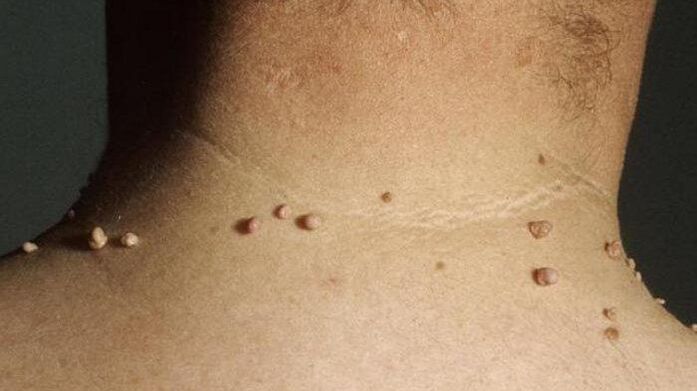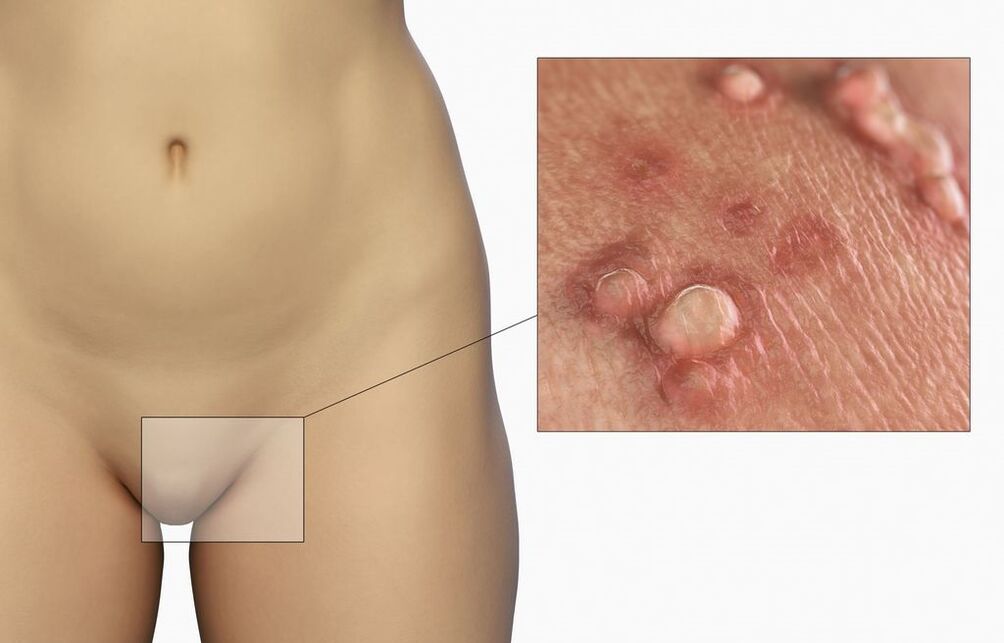Genital papillomatosis increases the risk of infection for both partners and complicates intimate life, and is often transmitted from woman to child during childbirth.

Causes
The main cause of growths is HPV, which enters the body in various ways. It is injected into the squamous epithelial cells and stays in them for a long time without announcing itself. The patient may not be aware of such an infection until the conditions are in place for it to multiply and for the tumors to appear. Growths often appear on the body as immunity declines.
Experts identify factors that increase the risk of growth:
- frequent stress;
- nervous, physical excessive work;
- avitaminosis;
- reduced immunity;
- the age of the patient;
- too many sexual partners;
- smoking, excessive alcohol consumption;
- long-term use of oral contraceptives.
The causes of papillomas can be hidden in disorders of the endocrine system, pathologies of the digestive system, due to overweight. The incubation period lasts for about a year, and if the immune system is working well, the infection may not work. HPV is often transmitted in daily life by coming into contact with infected items using ordinary washing cloths, razors and towels. The infection can occur during sexual intercourse or from woman to child during childbirth.
Views
Dermatologists distinguish several types of papillomas:
- Simple. The neoplasm looks like cauliflower or cabbage, the surface of which resembles small papillae.
- Plantar. This buildup causes little discomfort.
- Flat. The site of localization of such neoplasms is the cervical epithelium. Flat papillomas look like flat nodules that are itchy.
- Filamentous. Such tumors are often seen in patients over 50 years of age, appear as small nodules and do not cause severe symptoms.
- Spikes. They resemble papillary formations that are localized both as separate elements and converge into whole groups. In each case, genital warts are provoked by certain types of virus that are transmitted during sexual intercourse. The site of genital warts is the intimate area, groin, anus, perineum.
Angiopapiloma is an internal formation made up of connective tissue. It attaches to the walls of blood vessels and can provoke the development of cancer.
Neoplasms in the visible areas of the body and in the intimate area often cause problems of psychological discomfort and sexual activity. Uterine papilloma can lead to cancer.
Kinds
There are several types of HPV, depending on the possible damage to the skin and internal organs.
Flat
The onset of papilloma is associated with rapid growth of epidermal squamous epithelium. In young people, these types of tumors can form too often in injured areas of the body.
Squamous cell papillomas are round tumors with a broad base and neoplasms with a thin stem. At the beginning of development, they are stationary, painted in light or brown tones. Permanent trauma to such formations can provoke inflammation, cell mutations and cancer. Without effective treatment, there is a high risk of developing cancer.
Inverted
Reverse papilloma appears quite rarely on the body. The area of its appearance is the nasal cavity and the paranasal sinuses. Growth of neoplasms in the anterior and maxillary sinuses is possible.
The hallmark of papillomavirus is unilateral damage. Germination of the inverted bone formation, which results in damage to the palate, skull, sinuses and orbital walls, is possible.
Reverse large papilloma causes nasal congestion, bleeding and nasal discharge. When the tumor grows to a large size, the skeleton of the face is deformed and directed toward the affected visual organ.
Localization
Skin papillomas can form in different parts of the body. Discomfort is caused by formations on the face, and when placed on the body, they are constantly injured by contact with clothing.
Experts identify several places where papillomas occur:
- Inguinal area, armpits and lower abdomen with obesity. Different types of neoplasms can be localized under the breasts of the fairer sex.
- Neck, face, abdomen, back area. The area of the papilloma on the face mainly becomes the area of the mouth, eyes and eyelids.
- Genitals. This area is often the site of genital warts.
- Internal organs. Neoplasms appear in the tissues of the intestine, stomach and bladder.
- Feet. Spinal warts often appear in this part of the body.
The site of viral neoplasms may be the oral mucosa, bladder, mammary glands, internal genitals.
Educational symptoms
When HPV is activated, various types of neoplasms appear on the skin. Their signs are similar to each other, but there are differences.

Warts
Wart formation on the skin can be detected by certain symptoms:
- the size of the tumor does not exceed 1 cm;
- the warts have clear outer boundaries, an uneven surface and density is palpable;
- accumulation color can range from light gray to black;
- the neoplasm has an irregular rounded shape.
The site of growth is mainly open areas of the body, and especially those that are constantly injured by something. Warts often appear on the hands, fingers, knees and scalp.
Papillomas
You can diagnose growth yourself if you know what your papilloma body looks like. These are skin growths with a fairly thin stem or flat base. Infection with the virus mostly occurs in public places with high humidity. It is in this environment that he feels perfect and begins to multiply rapidly.

Patients need to know what papillomas look like on the body. The first sign of a tumor is a slight burning sensation, a slight tingling sensation in the epidermis. After a while, new growths appear in this area. Gradually they stretch and lengthen, their size increases to 1-1, 5 cm.
Often, papilloma of the skin develops in elderly patients and begins to actively grow. The area where the growths are is the chest, the groin area and the area under the armpits. They are painted flesh-colored or slightly yellow. The presence of the virus in a woman's body significantly increases the risk of developing cervical cancer.
Warts

Genital warts are caused by certain types of HPV, which enter the bloodstream only through sexual intercourse. The anus and external genital area usually become the focus of growth localization, less commonly oropharnexis.
Warts are papillary growths that form in different parts of the body. The individual elements often connect to each other and form a tumor that resembles a rooster's comb.
Incubation period
Papillomavirus has a long incubation period that can last for many years. This means that it is quite difficult to determine when the infectious agent has entered the body. The activity of the virus may be increased by various factors that affect the way the immune system works.
Once in the body, the virus enters the nuclei of dermal cells and begins to multiply rapidly. As the body's defenses diminish, small papillae begin to appear on the surface of the skin, enclosing several cells. They grow slowly and can reach 10 cm.
Diagnostics
Diagnosis of papilloma begins with an examination of the patient by an immunologist or dermatologist. The patient's history and symptoms are checked. Laboratory and instrumental studies help to identify the cause of neoplasms on the body.

The standard diagnostic program includes:
- general and biochemical blood analysis;
- PCR tests;
- material biopsy.
Based on the results of the study, effective and safe treatment methods are selected.
Treatment
It is recommended that treatment for papillomas begin as soon as they are detected. The choice of method depends on the localization area of the neoplasms, the reasons for their appearance, the form of HPV. Only a specialist can determine how to quickly cure papilloma.
Cryocoagulation
With this method of treatment, the neoplasms are removed with liquid nitrogen, which causes the water cells to freeze and die. Cryodestruction is performed only if the tumor is benign and free of cancer cells.

The procedure is considered painless, but if the skin is too sensitive, they use novocaine. After treating the skin with liquid nitrogen, it turns white and a small bubble forms, inside which a clear or pink liquid accumulates. When the growths are removed by freezing, unpleasant sensations may appear in the form of a burning sensation, but they gradually disappear. After cryodestruction, it is recommended to treat the epidermis several times a day with a solution of potassium permanganate or boron alcohol.
After a few days, the bladder bursts and a crust forms, which protects the wound from infection. Over time, it disappears and healthy skin remains under it.
Surgical method
Surgery to remove the papilloma from the skin is considered to be the most radical method of removal, but it is not used as often. The indication for surgery is large papillomas.

During the operation, the doctor excises a small area of healthy tissue, which prevents the growth from growing again. The procedure is performed under local anesthesia and lasts no more than 10-15 minutes. The patient does not feel pain and a suture is applied after the manipulation is completed. The lack of this method is considered a long period of wound healing, scarring, scars on the body.
Laser removal
The doctor will decide how the papilloma will be treated after examining the patient. The most modern method of removing growths is considered to be laser therapy, which is preceded by an analysis to exclude cancer cells. The area of the body where the papilloma is located is anesthetized with lidocaine. They then act on it with a laser beam and completely remove it. In this treatment, the damaged cells evaporate water, dry out and form a crust.
After a while the skin becomes red, swollen, but this reaction occurs after 2-3 days. The crust itself falls off after 5-7 days, and instead a soft pink skin appears.
Chemical attack
An effective way to combat pathology is considered to be a chemical effect on the papilloma. Genital warts are removed with special preparations that contain organic acids.
With the help of an applicator, they are applied to the surface of the formation and are cauterized. Under the influence of chemicals, growth cells are destroyed and disappear.
Medication
Medical treatment for papilloma includes:
- Pills. Infection with the virus is due to a decrease in immunity, so the effect of the medicine is to increase the body's defenses. The patient is expected to take vitamins, immunomodulators, antivirals.
- Preparations for topical treatment. The use of creams and ointments with antiviral effect is a good effect. Gels and creams that stimulate the production of interferon are chosen for small penile tumors. To remove growths, your doctor will prescribe solutions with cauterizing properties.
Only a doctor can determine whether to remove papillomas in different parts of the body.
Immunomodulators
How to treat multiple papillomas on the body depends on their size and localization area. An integrated approach involves treatment with immunomodulators, which activate the body's natural defenses.
There are several types of HPV, so these medicines should be chosen by a specialist after immunological tests. Women with papillomas are advised to pay special attention to natural immunomodulators that help restore immunity to DNA levels.
Self-erasing
Treatment of large papillomas at home can worsen a person's condition and cause the virus to spread throughout the body. The possibility of using self-growth products is determined by a dermatologist. This method of treatment is only possible in the absence of an oncogenic factor and a suspected malignancy.
Self-treatment of benign neoplasms involves the use of topical ointments and medications prescribed by a doctor.
Traditional treatment methods
Alternative therapies may be used in addition to the treatment regimen chosen by the physician. It is possible to stop the intensive growth of papillomas and provoke their destruction if it is smeared with celandine, dandelion or sour apple juice.

You can lubricate the neoplasm with fresh egg white every day and wait for it to dry. After a while, the dry papilloma itself will fall off. You can buy a special adhesive tape at the pharmacy, which is glued for a long time and then the tumor is cleaned.
To prevent the defect, it is recommended to cut a clove of garlic and rub it on the skin for several days in a row.
Treatment with home and folk remedies is a long process. It is recommended that it be combined with antiviral medicines to increase their effectiveness.
Prevention
Prevention of the human papillomavirus is possible through the hygiene of the body, the timely treatment of all epidermal injuries and their healing. You must use personal care products to prevent infection.
Papilloma prevention includes accidental sexual rejection, a healthy lifestyle, and increased immunity. The virus can become a provocative factor in the development of cervical papilloma and cancer. Women should see a mammologist and gynecologist regularly, be sure to follow a proper diet. It is advisable to ask your doctor, rather than self-medication, if you have papilloma.
















































































